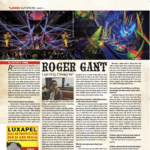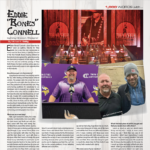Scott Barnes, a lighting console programmer for motion pictures, recently took some time out of his busy production schedule to speak with PLSN about how he got started in the industry and some milestones of his career. So far, that career has included working on many of today’s biggest blockbuster films. In all, Barnes has been building a massive resume of work on more than 50 films. He has worked extensively on the Marvel franchise, starting with Iron Man and continuing through the currently filming of Avengers: Infinity Wars, Parts I and II.
PLSN: Did you always want to work in films? And how did you get started?
Scott Barnes: I went to high school outside of Dallas in Carrollton, Texas, where I was involved in technical theatre. I was already sort of in love with the film business, I already knew that was kind of where I want to be heading, but I didn’t know in what capacity. So right out of high school, I interned at a place called Victor Duncan Incorporated, in their Dallas location. Then I was working on commercials and a little bit of television in the Dallas area. Actually, the first time I worked on a movie set was back in Dallas. There was a movie of the week, a television movie, that came through in Denton, Texas that I worked on. It had George C. Scott in it; I got a great photo of me and George C. Scott sitting there. I was like 19 or something and that was actually my first experience on the set.
After I left Victor Duncan, I went to work briefly with Cinemark Theatres. I’ve always been a painter, an artist and a designer. After the owner and CEO of Cinemark, Lee Roy Mitchell, was photographed for a magazine article standing in front of murals I had painted at one of his theatres, he invited me to his office and asked me to come work at Cinemark as an in-house graphic designer. I spent about a year and half, two years working there. It was great, it really opened me up to doing more work on a computer for all my graphic arts and stuff.
Then a buddy of mine, Scott Poole, who had moved to L.A. from Texas and became a location scout out there, called and told me how busy he was in California. He said, ‘Man, if you still want to get into this business, this is the time to come out here.’ It was Scott who got me started in the business in L.A. — he introduced me to a couple people, I started getting some work, and I got into the union, Local 728, really fast.
How did you get into doing the lighting console programming?
One of the first guys I met when I got out there and started working was a guy named Mike Bauman. He is a gaffer today, but he was a best boy when I met him. He is someone I really kind of owe my career to — well, him, and, of course, Scott. He was the first guy that put me to work in lighting, and because of my experience with graphic arts he thought I might be really good at doing plotting. So, I start doing some plots for some of the shows we were working on, and he was also the first guy to throw me on a lighting console.
That was back in the day when, if consoles where even used at all, it was set up in a corner and somebody would just go over and slide something up if we needed it to dim. That was in television. In feature films, they were really rarely used. Unless there was some sort of specialty lighting that they needed to do for a gag, but the idea of having someone on the console for the entire movie was just not done.
Like I said, it was Mike who threw me on a console the first time, when we brought an Expression in for a two-week period on a movie called The Thirteenth Floor. I learned it, and never looked back. I’ve just kind of kept going.
Working on The Grinch, I meet Alan Rowe, and he got me working on the Wholehog 2. That was one of those moments like, ‘Wow, all the things I could start doing.’ That’s one of the things I love about my job, new technology. I enjoy playing with new features on a console or trying a different console. It’s just learning new technology and learning new things that improve what I do. I always try to do things better from film to film.
What do you think is the essential element needed in the programmer/ gaffer/ DP relationship?
I don’t want to cop out and say it’s different for everyone, but it is different for everyone. I think, overall, you’ve got to have patience, for sure. You know what it is? It is that you have to be able to sit back and read who you’re working for and determine how you need to work with that person. Because you can’t just jump in and start being the guy that tells them how you’re going to do things. You first need to figure out, ‘Is this the kind of guy that I can make really good suggestions for, help with creative decisions, or do I really need to literally just shut my mouth, let him tell me what I need to do and push buttons.’ You need to keep in mind that they’re not hiring a console, they’re hiring a person. The question for them is, ‘Is the person that’s running this console someone I want to work with?’ I am proud that I have got a really good reputation of being able to adapt to how people want to work. So I think, definitely, the number one element would be just reading people the correct way and adapting, not necessarily your personality, but to the style of work, and that’s what gets you more work.
What do you consider some milestones in your career?
Grinch was definitely a milestone. I think Lemony Snicket was a milestone. Ironman and Ironman 2 were milestones. Certainly Ironman, where the whole Marvel thing started. No one knew, I mean, definitely, I didn’t know, that it would become what it is, that it was going to be so big. It’s been a cool experience. Yeah, those movies I mentioned were definitely, for different reasons, they were all milestones for me.
Also. Dreamgirls. I will always remember working for Jules [Fisher] and Peggy [Eisenhauer] and meeting Harry Sangmeister. I was just as an up-and-comer programmer who had never really done live, or anything, so to just be able to watch Harry work and get a few tips, plus seeing Jules and Peggy do what they do. It was a great learning experience and on such a really good, beautiful movie, too. It was a fun movie to work on it. That job just kind of happened to cross me, and I met these people and I was like, ‘Wow, this is amazing.’ I have been fortunate to be able to learn all along on each film and take that onto the next. It is really fun and I love it.


